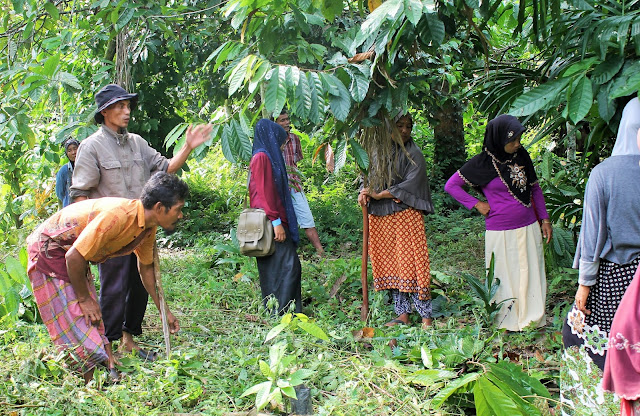A few months
ago I posted some information on an international agency that had received 6.7
million in 2008 from the post-tsunami economic development funds to do a
massive cocoa improvement project in 5 districts, one of which was Aceh Timur. Its final report to World Bank indicated that
of the over 4,500 farmers the project was going to serve, at least 1,200 were
in Aceh Timur. Since JMD had never heard of either the agency or its proposed
project, or that there were 1,200 cocoa farmers receiving services in the
district in which JMD worked, staff visited the area in 2012 and found . . .
goose egg. No one had received services,
promised facilities had not been constructed, the 9 requisitioned vehicles were
nowhere to be found, and $6.7 million had disappeared—poof! like that.
Which is one
of the many reasons why my blood boils when I am told that large contracts
should only go to “established” international agencies because they are the
only ones capable of handling the money.
Well, they
handled it all right.
Anyway . . .
What JMD did
find in its visit to the northwestern part of Aceh Timur was a 10-village
community in the sub-district of Pante Bidari with fertile soil, great
conditions, and great potential for growing cocoa, but whose farmers had
received no training in how to do really good organic pest management, which
makes the difference between weak, scraggly, non-productive trees and the trees
we’re now seeing in Simpang Jernih.
Like Simpang
Jernih sub district, the communities in Pante Bidari lie on the buffer of the
rainforest, and citizens are still recovering from the effects of the 30-year
protracted conflict. So JMD asked its
current project donor, the Embassy of Finland’s LCF (Local Community Funds)
program, to divert some funding that was to be used for a Rainforest Alliance
pre-certification visit and allocate it to a 4-month cocoa improvement project
in Pante Bidari. Unfortunately, as we
found out, Aceh Timur is still lagging behind when it comes to cocoa farm
certification, and so a visit at this time wouldn’t be too beneficial, since
buyers are paying the same amount for uncertified cocoa as they would for
certified. An RA visit is an expensive
proposition also, and so the nice people with LCF agreed to allow the transfer so that residents could begin to re-claim the
livelihoods their ancestors lost during the conflict.
Here's a map of Aceh Timur (most of it) showing Pante BIdari. Simpang Jernih, about 40km south, is the dot right below the magnifying glass and to the right a bit--see how it's right on the river (that you have to cross by raft to get from Simpang Jernih Village to Pante Kera.) Pante Bidari is about 4 hours from the main road which should make for easier farm-to-market access, but JMD reports the connector road is still pretty bad.
Our plan is this: JMD is contracting with our
very intrepid trainer to conduct 3-day pest-control trainings in 4 separate communities. These trainings will be similar to the
training that farmers received this past summer (weeding, pruning, maintenance
for healthy plants, integrated pest management) and include training in how to
create liquid organic fertilizer/pest control.
We’re estimating that estimate that 20 cocoa
farmers, predominantly women, will attend each training.
So for a relatively small amount of funding JMD
will be able to reach at least 80 farmers, and through one training component
they will have tangible evidence that it’s possible to re-establish cocoa
farming as economically viable livelihood. In this way, Aceh Timur
district will be closer to the economy of scale necessary for an organic
certification process to make an economic difference in the lives of these
farmers.
Junaidi and Robert will be traveling to Pante
Bidari next week to meet with lots of people, including all the village chiefs
(Camats) as well as representatives from the Forestry and Agriculture
Department. Plus (and this is where it
gets interesting) they have submitted requests and itineraries to the Aceh
Military base and local police departments because (of course!) the bad guy du
jour, one Din Minimi, and his band of separatist thugs are said to be holed up
somewhere in that very sub district, and gunfire has been exchanged in recent
weeks. I am extremely concerned for the
staff’s safety, but I wanted to mention this because this tiny agency is going
where no one else dares to, and it can’t even get funding from any international
agency (besides LCF) to increase its programming or administration. World Bank gives $6.7 million to an agency
that disappears, but because JMD is local they get bupkus . . . and still they
are going to go try to make a difference in the lives of the rural poor in the
province where everyone else is too frightened to venture.
I’ll try to post some photos when I get
them. Go to JMD’s website. Make a donation. Support this agency and help these cocoa
farmers. This matters.






